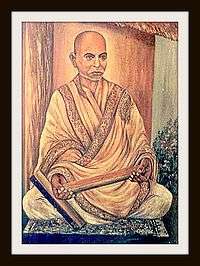Pathani Samanta
Mahamahopadhyaya Chandrasekhara Singha Harichandana Mahapatra Samanta (Odia: ମହାମହୋପାଧ୍ୟାୟ ଚନ୍ଦ୍ରଶେଖର ସିଂହ ହରିଚନ୍ଦନ ମହାପାତ୍ର ସାମନ୍ତ), popularly known as Pathani Samanta (Odia: ପଠାଣି ସାମନ୍ତ) (13 December 1835 - 11 June 1904) was an Indian astronomer and scholar who measured the distance from earth with a bamboo pipe and many other traditional instruments that he built. This earned him the "Mahamahopadhyaya" award in 1893. His observations, research and calculations were compiled into a book Siddhanta Darpana which has verses written in Sanskrit in Odia script.[1]
Pathani Samanta ପଠାଣି ସାମନ୍ତ | |
|---|---|
 | |
| Born | 13 December 1835 Khandapada, Nayagarh District, Odisha |
| Died | 11 June 1904 (aged 67) |
| Known for | Naked eye astronomy |
Early life
Samanta was born in the princely state of Khandapada in Nayagarh district in the Indian state of Odisha.[2] He was an eminent naked eye astronomer. He studied in Sanskrit and researched traditional Indian astronomy. Pathani Samanta was born on 13-12-1835 Sunday (Purnimanta Pousha Krishna Ashtami) and he died on 11-06-1904 Saturday (Purnimanta Adhika Jyeshtha Krishna Trayodashi)'. He was the son of Samanta Syamabandhu Singha and Bishnumali Devi.Even if he was born in royal family,he was poor
In his childhood he used to measure the length of the shadow in different parts of day. He also measured that how many vultures are flying how far in the sky and in what speed with naked eyes.
Instrument maker
During his research, he built many instruments using available materials such as wooden sticks and bamboo. His knowledge of astronomy ensured that these instruments had great accuracy. His findings were recorded in his book titled Siddhanta Darpan. This book found mentions in the European and American press in 1899. Samanta’s calculations are used in the preparation of almanacs in Odisha. The calculations in "Siddhanta Darpan" were done only with the help of a bamboo pipe and two wooden sticks by him in night when he remained sleepless through his lifetime.[3]
References
- Naik, P. C.; Satpathy, L. (1998). "Samanta Chandra Sekhar : The great naked eye astronomer". Bulletin of the Astronomical Society of India. 26: 33–49. Bibcode:1998BASI...26...33N.
- "EMINENT PERSONALITY".
- "Samanta Chandrasekhar". Archived from the original on February 22, 2014.
Bibliography
- Satpathy, L., ed. (2003). "Samanta Chandra Sekhar and his Contributions to Ancient Indian Astronomy.". Ancient Indian Astronomy and Contributions of Samanta Chandra Sekhar. ISBN 9788173194320.
- "Samanta Chandra Sekhara and His Treatise Siddhantadarpana.". 500 years of Tantrasangraha: a landmark in the history of astronomy. 2002. p. 127. ISBN 9788179860090.